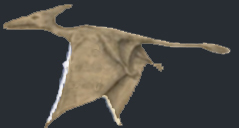Many sea creatures have bioluminescence, but few flying creatures of the sky glow, at least according to what science textbooks tell us. The firefly is an exception. But what if the textbooks have overlooked a large flying creature that has been thought long extinct: a pterosaur? What if eyewitness accounts are correct about large glowing pterosaurs flying at night?
A recent report, from a researcher and explorer, who has seen these nocturnal creatures himself, indicates one of the pterosaurs had a glow on the leading edge of the wings. One eyewitness described the bright glow from one wings. That light penetrated the other wing, detailing the inner structure of that wing for a moment. The eyewitness saw the semi-transparency of that wing. Amazing! The location is secret, but this secrecy may be temporary.
The puzzle cries for a solution; Mr. Hendricks and I agree. I respectfully disagree with his general assumption (something like an atmostpheric phenomenon, non-living). I credit him for his work, but credit the Marfa Lights to the flights of cryptids, notwithstanding they differ from flights of birds and bats. Why do they seem, at times, to dance? Why do two lights fly apart, then turn and fly back together? The dance sometimes appears complex but the purpose is simple. It’s just their technique: a way to catch bats.
(Note: popular scientific models in paleontology do not generally include speculation about bioluminescence or lack of it in pterosaurs represented by fossils, for bones do not have enough information)
Some eyewitnesses see glowing “pterodactyls” or a large or giant flying object that shines where large or giant pterosaurs have been seen to fly. . . . my associates and I believe the day will come when biology textbooks will include that subject. Future discoveries may reveal something about the biological chemistry involved, for it may differ from the bioluminescent of other organisms such as fireflies.
. . . local residents have speculated about dancing devils or ghosts. Scientists have preferred something along the lines of ball lightning or earthlights, but all their scientific explanations have tripped over the resemblances to line dancing. . . . why do two lights horizontally separate for a long distance before coming back together?
All About Marfa Lights and Pterosaurs
They have been called dragons, fiery flying serpents, ropens, and pterosaurs. What about Marfa Lights? Those that fit into what Bunnell calls “CE-III” mystery lights characteristics—those lights behave like they were intelligent. Perhaps the old legends of crafty dragons are not 100% fictional.
But eyewitnesses who have been brave enough to report a living pterosaur themselves live in various states of the U.S.A., including various parts of Texas and in New Mexico. Many of these sightings resemble those in Papua New Guinea: feather-less flying creatures with head crests and long tails, and when long tails are seen, the end of the tail is often seen to have a structure suggesting the tail of a Rhamphorhynchoid pterosaur.



